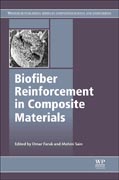Natural fiber-reinforced composites have the potential to replace synthetic composites, leading to less expensive, stronger and more environmentally-friendly materials. This book provides a detailed review on how a broad range of biofibers can be used as reinforcements in composites and assesses their overall performance. The book is divided into five major parts according to the origins of the different biofibers. Part I contains chapters on bast fibers, Part II; leaf fibers, Part III; seed fibers, Part IV; grass, reed and cane fibers, and finally Part V covers wood, cellulosic and other fibers including cellulosic nanofibers. Each chapter reviews a specific type of biofiber providing detailed information on the sources of each fiber, their cultivation, how to process and prepare them, and how to integrate them into composite materials. The chapters outline current and potential applications for each fiber and discuss their main strengths and weaknesses. The book is divided into five major parts according to the origins of the different biofibers - bast, leaf, seed; grass, reed and cane fibers, and finally wood, cellulosic and other fibers including cellulosic nanofibers.This book provides a detailed review on how a broad range of biofibers can be used as reinforcements in composites and assesses their overall performanceThe chapters outline current and potential applications for each fiber and discuss their main strengths and weaknesses INDICE: Preface Part I Bast fibers 1 The use of jute fibers as reinforcements in composites J. A. Khan, National University of Bangladesh, Bangladesh and M. A. Khan, Bangladesh Atomic Energy Commission, Bangladesh 2 The use of flax fibers as reinforcements in composites J. Müssig and K. Haag, Hochschule Bremen - University of Applied Sciences, Germany 3 The use of hemp fibers in composites H. N. Dhakal and Z. Zhang, University of Portsmouth, UK 4 The use of ramie fibers as reinforcements in composites Y. Du, N. Yan and M. T. Kortschot, University of Toronto, Canada 5 The use of kenaf fibers as reinforcements in composites H. Akil, M. H. Zamri and M. R. Osman, University of Sains, Malaysia Part II Leaf fibers 6 The use of sisal and henequen fibers as reinforcements in composites Y. Li and Y. O. Shen, Tongji University, China 7 The use of pineapple leaf fibers as reinforcements in composites A. L. Leao, São Paulo State University (UNESP), Brazil, B. M. Cherian and S. Narine, Trent University, Canada, S. F. de Souza and M. Sain, University of Toronto, Canada, and S. Thomas, Mahatma Gandhi University, India 8 The use of banana and abaca fibers as reinforcements in composites A. A. Mamun and H. P. Heim, University of Kassel, Germany, O. Faruk, University of Toronto, Canada; and A. Bledzki, University of Kassel, Germany and West Pomeranian University of Technology, Poland 9 The use of palm leaf fibers as reinforcements in composites D. Kocak and S. I. Mistik, Marmara University, Turkey Part III Seed fibers 10 The use of coir/coconut fibers and reinforcements in composites D. Verma, Indian Institute of Technology, B.H.U., Varanasi, India; and P.C. Gope, College of Technology, India 11 The use of cotton fibers as reinforcements in composites S. K. Bajpai and G. Mary, Government Model Science College(Autonomous), India; and N. Chaud, Advanced Materials and Processes Research Institute (AMPRI) (CSIR), India. 12 The use of palm oil biomass (OPB) fibers as reinforcements in composites M. D. H. Beg, M. F. Mina, R. M. Yunus and A.K.M. Moshiul Alam, Universiti Malaysia Pahang, Malaysia. Part IV Grass, reed and cane fibers 13 The use of rice straw and husk fibers as reinforcements in composites M. Bassyouni, King Abdulaziz University, Saudi Arabia and Higher Technological Institute, Egypt; and S. Waheed ul Hasan, Kind Abdulaziz University, Saudi Arabia. 14 The use of wheat straw fibers as reinforcements in composites S. Panthapulakkal and M. Sain, University of Toronto, Canada. 15 The use of maize, oat, barley and rye fibres as reinforcements in composites A. A. Mamun and H. Heim, University of Kassel, Germany and A. Bledzki, West Pomeranian University of Technology, Poland. 16 The use of bamboo fibers as reinforcements in composites M. S. Alwani, H.P.S. Abdul Khalil, M. N. Islam, S. S. Suhaily, R. Dungani and Y. M. H'ng, Universiti Sains Malaysia, Malaysia; M. Jawaid, Universiti Putra Malaysia, Malaysia. 17 The use of sugar cane/bagasse fibers as reinforcements in composites H. Hajiha and M. Sain, Centre for Biocomposites and Biomaterials Processing, Canada. Part V Wood, cellulosic and other fibers 18 Isolation and application of cellulosic fibres in composites R. A. Shanks, RMIT University, Australia 19 The use of biobased nanofibers in composites S. Bandyopadhyay-Ghosh and S. B. Ghosh, Birla Institute of Technology and Science, India and University of Toronto, Canada, and M. Sain, University of Toronto, Canada 20 The use of wood fibers as reinforcements in composites L. M. Matuana, Michigan State University, USA; and N. M. Stark, USDA Forest Service, Forest Products Laboratory, USA 21 The use of luffa cylindrica fibers as reinforcements in composites D. Kocak, S. I. Mistik and M. Akalin, Marmara University, Turkey; and N. Merdan, Istanbul Commerce University, Turkey. 22 The use of curaura fibers as reinforcements in composites S. F. Souza and M. Ferreira, Universidade Federal do ABC, Brazil; M.Sain, University of Toronto, Canada; and M. Z. Ferreira, H. F. Pupo, B. M. Cherian and A. L. Leao, Sao Paulo State University, Brazil.
- ISBN: 978-1-78242-122-1
- Editorial: Woodhead Publishing
- Encuadernacion: Cartoné
- Páginas: 768
- Fecha Publicación: 24/09/2014
- Nº Volúmenes: 1
- Idioma: Inglés

